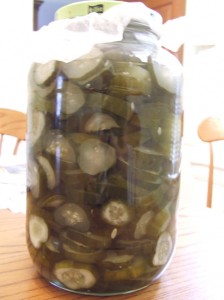by David Cecelski
A few days ago, I visited my cousin Eloise to pick up a half-gallon jar of sweet pickles. Her pickles are famous in these parts and it’s a trip that I look forward to every summer, partly because I like her pickles so much, partly because I enjoy her company so much, and partly because I know that my visit will end with me and her 86-year-old brother next door sitting outside in the night air and smoking cigars and eating watermelon.
Eloise makes the sweetest, crispiest pickles in the world. And goodness knows how many gallons she makes every summer! I don’t know if I could count all the relatives and neighbors who couldn’t make it through the year without her sweet pickles on their dining room tables.
Making the pickles is not for the faint of heart though. Eloise is a legendarily hard worker and she doesn’t believe in taking short cuts about anything, including her pickles. There are plenty of pickle recipes that only take a few hours, but Eloise favors an old recipe that originally came from her sister-in-law’s aunt in Seven Springs, in WayneCounty, and it requires Herculean effort over a period of nearly two weeks.
Here’s the recipe that Eloise shared with me:
After she and her brother pick their cucumbers (she prefers using medium-sized ones), she cuts them into 1 and ½ to 2 inch pieces. Then, on that first day of her pickle making, she mixes 1 cup of salt to 1 gallon of boiling water and pours that mixture over the pickles and lets them sit a day.
She says be sure to avoid using aluminum containers to fix the pickles—I don’t know why. Eloise likes to use plastic buckets. Also, when you drain that water off, the cucumbers may look a little fuzzy, she warned me, but she said don’t worry.
The next thing she does—on the second day—is pour ¾ cup powdered alum to 1 gallon boiling water over the pickles and lets them sit another day. She sets a jar or something else heavy on top to make sure that all the cucumbers stay underwater. She drains the container after a day and then, on the 3rd day, she soaks them again, but this time just in 1 gallon of boiling water.
A day later—the 4th day—she drains them again and then bundles up her pickling spices, a mixture of mustard seed, coriander, bay leaf, dill seed, red pepper, cloves and allspice that you can find at your local grocery store. She wraps the pickling spices in a cloth and places them in the pot and adds cider vinegar and brings it to a boil. She lets the cucumbers soak in that mixture for 8 days. Then she drains off the vinegar.
(She says, by the way, that the drained vinegar plus a tablespoon of dish detergent in a spray bottle makes a great weed killer.)
Next she cuts the pickles into smaller, maybe ¼ to ½ inch slices. Then she places them in a wide-mouth jar, a layer of pickles, a layer of sugar, until the jar is nearly full. She says that you should expect to use roughly 5 pounds of sugar for every gallon of pickles. The sugar will melt and make syrup. If there is not enough syrup to cover the pickles, she cautioned me, add more sugar. She also said that you should keep shaking the pickle jars to help dissolve the sugar. Turning the jars in the palm of your hand like you do a rolling pin works best, she says. Finally, she puts a sheet of wax paper across the top of each jar to keep the lids from rusting and then screws on the tops good and tight.
When they’re done at long last, Eloise’s pickles are really, really sweet, incredibly crisp and very delicious. The amazing thing to me is that they are preserved just in the liquid that the sugar draws out of the cucumbers, not in any extra vinegar at all. Around here they don’t last long. I keep mine on my kitchen counter and we’ve got friends and neighbors that head straight for that jar every time that they come into the house.

How can I get on her list of purchasers? I would make the drive to NC just for good pickles. I desperately love gherkins. Just can’t get them. Very few sweet pickles compared to dill in the stores.